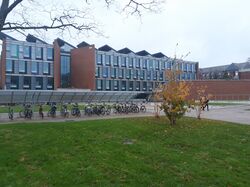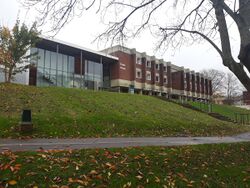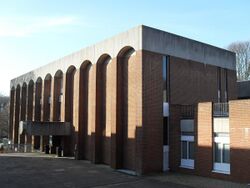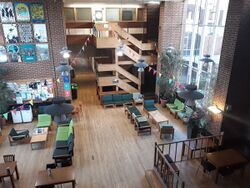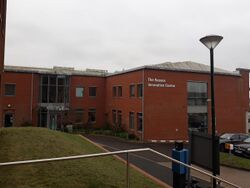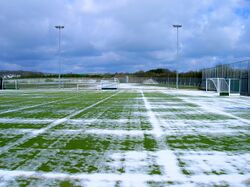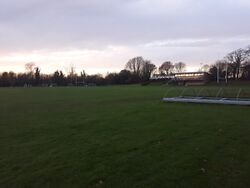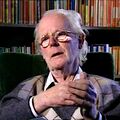University of Sussex
Topic: Organization
 From HandWiki - Reading time: 35 min
From HandWiki - Reading time: 35 min
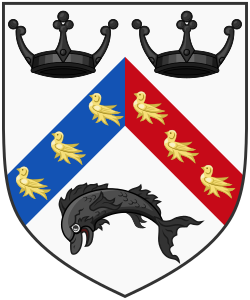 Coat of Arms of the University of Sussex | |
| Motto | English: Be Still and Know |
|---|---|
| Type | Public research university |
| Established |
|
| Endowment | £16.4 million (2023)[1] |
| Budget | £380.1 million (2022/23)[1] |
| Chancellor | Sanjeev Bhaskar |
| Vice-Chancellor | Sasha Roseneil[2] |
| Visitor | King Charles III |
Academic staff | 2,150 (2021/22)[3] |
Administrative staff | 1,370 (2021/22)[3] |
| Students | 19,865 (2021/22)[4] |
| Undergraduates | 14,685 (2021/22)[4] |
| Postgraduates | 5,175 (2021/22)[4] |
| Location | Falmer, Brighton , East Sussex , England |
| Campus | Campus |
| White and Flint |u}}rs | White and Flint |
| Affiliations | Universities UK, BUCS, Sepnet, SeNSS, Association of Commonwealth Universities, NCUB |
| Mascot | Badger |
| Website | sussex |
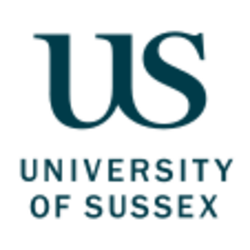 | |
The University of Sussex is a public research university located in Falmer, East Sussex, England. It lies mostly within the city boundaries of Brighton and Hove. Its large campus site is surrounded by the South Downs National Park, and provides convenient access to central Brighton 5.5 kilometres (3.4 mi) away. The university received its royal charter in August 1961, the first of the plate glass university generation.[5]
More than a third of its students are enrolled in postgraduate programmes and approximately a third of staff are from outside the United Kingdom.[6] Sussex has a diverse community of nearly 20,000 students, with around one in three being foreign students, and over 1,000 academics, representing over 140 different nationalities.[7][8] The annual income of the institution for 2022–23 was £380.1 million with an expenditure of £345.1 million.[1]
Sussex counts five Nobel Prize winners, 15 Fellows of the Royal Society, 10 Fellows of the British Academy, 24 fellows of the Academy of Social Sciences and a winner of the Crafoord Prize among its faculty. By 2011, many of its faculty members had also received the Royal Society of Literature Prize, the Order of the British Empire and the Bancroft Prize. Alumni include heads of states, diplomats, politicians, eminent scientists and activists.
History
20th century
In an effort to establish a university to serve Sussex, a public meeting was held in December 1911 at the Royal Pavilion in Brighton to discover ways to fund the construction of a university; the project was halted by World War I, and the money raised was used instead for books for the Municipal Technical College.
The idea was revived in the 1950s, and in June 1958 the government approved the corporation's scheme for a university at Brighton, to be the first of a new generation of what came to be known as plate glass universities.[5] The university was established as a company in 1959, with a Royal Charter being granted on 16 August 1961.[5] This was the first university to be established in the UK since the Second World War, apart from Keele University. The university's organisation broke new ground in seeing the campus divided into Schools of Study, with students able to benefit from a multidisciplinary teaching environment. Sussex would emphasise cross-disciplinary activity, so that students would emerge from the university with a range of background or 'contextual' knowledge to complement their specialist 'core' skills in a particular subject area.[9] For example, arts students spent their first year taking sciences while science students took arts.This experimental interdisciplinary educational model was famously described by Professor Asa Briggs as pioneering "a new map of learning".[10]
The university grew from 52 students in 1961–62 to 3,200 in 1967–68. After starting at Knoyle Hall in Brighton, the Falmer campus was gradually built with Falmer House opening in 1962.[11] The campus was praised as gorgeously modernist and groundbreaking, receiving numerous awards.[12] The student union, as is typical,[13] organised events and concerts, bringing in acts like Pink Floyd, Jimi Hendrix and Chuck Berry to perform at the University Common Room.[14]
Academically, Sussex was home to figures such as Asa Lord Briggs, Helmut Pappe, Gillian Rose, Jennifer Platt and Tom Bottomore. In its first years, the university attracted a number of renowned academics such as Sir John Cornforth, John Maynard Smith, Martin Wight, David Daiches, Roger Blin-Stoyle and Colin Eaborn. Similarly, renowned scholars like Marcus Cunliffe, Gabriel Josipovici, Quentin Bell, Dame Helen Wallace, Stuart Sutherland and Marie Jahoda also became central figures at the university and founded many of its current departments. Additionally, a number of initiatives at the university were started at this time, such as the Subaltern Studies Group, founded by Ranajit Guha who was Reader in History at Sussex between 1962 and 1981.[15]
In the late 1960s, the United Nations asked for science policy recommendations from a team of renowned academics at Sussex. The ensuing report became known as the Sussex Manifesto.[16]
Sussex came to be identified with student radicalism. In 1973, a group of students prevented United States government adviser Samuel P. Huntington from giving a speech on campus, because of his involvement in the Vietnam War.[17] Similarly, when the spokesperson for the US embassy, Robert Beers, visited to give a talk to students entitled 'Vietnam in depth' three students were waiting outside Falmer House and threw a bucket of red paint over the diplomat as he was leaving.[18]
In both 1967 and 1969, Sussex won the television quiz University Challenge.[19]
In 1980, Sussex edged out the University of Oxford to become the university with the highest income from research grants and contracts.[20]
21st century
In an attempt to appeal to a modern audience, the university chose in 2004 to cease using its coat of arms[21] and to replace it with the "US" logo.[22]
In 2011, Sussex celebrated its 50th anniversary and saw the production of a number of works including a book on the university's history and an oral history and photography project. The university launched its first major fundraising campaign, Making the Future, and gathered over £51.3 million.[23]
The university underwent a number of changes with the Sussex Strategic Plan 2009–2015, including the introduction of new academic courses, the opening of new research centres, the renovation and refurbishment of a number of its schools and buildings as well as the ongoing expansion of its student housing facilities. The university has spent over £100 million on-campus redevelopment, which is ongoing with £500 million planned to be spent by the 2021.[citation needed]
Sussex is heavily involved with the larger community across England, especially in East Sussex. There are many regular community projects, such as children's activity camps, the Neighbourhood scheme, the community ambassador programme and Street Cleans. Local residents can receive free legal advice from Sussex's law school and get guidance on renting through Sussex's Rent Smart program.[24] The university also facilitates volunteering opportunities for a number of local and international organizations. The university also offers language courses for the public through its Sussex Centre for Language Studies.[25] The university runs the Sussex Conversations program, a media platform seeking to disseminate research to the wider community.[26]
In 2015–16, the university generated more than £407 million to the UK economy, with over £74.9 million in tax receipts.[27]
In September 2017, the university appointed Saul Becker as its first Provost and Jayne Aldridge as its first permanent Director for the Student Experience. These changes come as part of a number of structural changes the university has been introducing in the past years.[28]
In 2018, the university moved all of its investments out of fossil fuels (known as fossil fuel divestment) after a four-year student union run campaign.[29]
In October 2021 a student campaign called for Kathleen Stock's dismissal.[30] In October 2021, the university's vice-chancellor Professor Adam Tickell gave his support to Stock who has been accused of transphobia. The Times reported students have called for Stock's dismissal and claimed that she has been victimised.[31] Following Tickell's statement, the Sussex branch of the University and College Union (UCU) called for an investigation into "institutional transphobia" at the University of Sussex.[31] Students have accused the university management of being "anti-student and pro-transphobia".[32] Taiwo Owatemi, the Shadow Minister for Women and Equalities, called UCU's statement "strong and principled".[33]
In 2021, during the COVID-19 pandemic, Sussex was one of few universities that returned to real-world teaching. Most lectures at other universities chose to remain online-only.[34]
Campus
The University of Sussex is situated near the city of Brighton and Hove, next to the Stanmer Park reserve, and extends into the Lewes District in its eastern fringe. The closest train station is Falmer railway station, located at about nine minutes from Brighton station. The campus is also close to the medieval town of Lewes and is approximately an hour away from London.[35] Located within the South Downs National Park, it is the only English university existing in a National Park.[36]
The campus, designed by Sir Basil Spence, is next to the village of Falmer but mostly within the city boundaries of Brighton and Hove. It is close to the South Downs, which influenced Spence's design of the campus. In 1959, the Basil Spence and Partners company began planning and designing the campus, to be built over a 15-year period. In 1971, 17 buildings had been designed and built winning numerous awards including a medal from the Royal Institute of British Architects and a Civic Trust award.[12] Spence expressed his awe at the beauty of the surrounding region and designed the campus as a stream of low buildings so as not to disturb the natural scenery around. Brick was chosen throughout as it was the dominant material used across Sussex.[12] As the campus developed, Spence connected the buildings by a series of 'green, interlocking courtyards that he felt created a sense of enclosure'.[12]
The campus is self-contained, with facilities including eights cafes/restaurants, a post office, a Co-op Food store, a market, a bank, a pharmacy, a health centre (including a dentist) and childcare facilities.[37] Spence's designs were appreciated by architects; many of the campus buildings won awards. A number of features define these buildings, including the materials used and the fact that many of them have planted and tree-filled courtyards. The gatehouse-inspired Falmer House won a bronze medal from the Royal Institute of British Architects.[5] Another campus building, The Meeting House, won the Civic Trust award in 1969.[38] In 1993, the buildings which made up the core of Spence's designs were given listed building status, with Falmer House being awarded the highest designation, Grade 1, as a building of "exceptional interest".[38] A number of the original buildings are now Grade II listed buildings.[39]
Sussex laid claim to being the "only English university located entirely within a designated Area of Outstanding Natural Beauty".[40] It is now entirely surrounded by the newly founded South Downs National Park.
The Gardner Arts Centre, another of Basil Spence's designs, was opened in 1969 as the first university campus arts centre.[41] It had a 480-seat purpose-built theatre, a visual art gallery and studio space, and was frequently used for theatre and dance as well as showing a range of films on a modern cinema screen. The Centre closed in the summer of 2007:[42] withdrawal of funding and the cost of renovating the building were given as the key reasons. Following an extensive refurbishment, the Centre reopened as the Attenborough Centre for the Creative Arts (ACCA) in the autumn of 2015, and a public performance programme started in Spring 2016. The centre is now a national arts and performance hub hosting various kinds of performances year-round.
The campus has facilities such as the Genome Damage and Stability Centre; the medical imaging equipment at the Brighton and Sussex Medical School (BSMS); and the university's Library, until 2013 the home of the Mass Observation Archive, which relocated to The Keep, a purpose-built archive facility nearby.
Library
The university's main library is at the centre of its campus. It was opened by Queen Elizabeth II on 13 November 1964. The Royal Literary fund office is based at the Library, providing support for students around academic writing. The Library also houses a research support centre and a research hive for PhD students and research staff.[43] There is also a Skills Hub, training facilities, a support centre, a café and a Careers and Employability Centre.
There are also smaller libraries within individual schools and research centres, as well as The Keep.
The university holds a number of acclaimed collections and archives, mostly related to twentieth-century literary, political and cultural history. Collections include original manuscripts and first editions by Virginia Woolf, Jane Austen and Rudyard Kipling as well as The New Statesman Archive and the Mass-Observation Archive.
Organisation and administration
Schools of Studies
The university was founded with the unusual structure of "Schools of Study" (ubiquitously abbreviated to "schools") rather than traditional university departments within arts and science faculties.
In the early 1990s, the university promoted the system by claiming "[c]lusters of faculty [come] together within schools to pursue new areas of intellectual enquiry. The schools also foster broader intellectual links. Physics with Management Studies, Science and Engineering with European Studies, Economics with Mathematics all reach beyond conventional Arts/Science divisions."[44] By this time the original schools had been developed somewhat and were:
- African and Asian Studies (abbreviated to AFRAS)
- Biological Sciences (BIOLS)
- Chemistry and Molecular Sciences (MOLS)
- Cognitive and Computing Sciences (COGS)
- Cultural and Community Studies (CCS)
- Engineering and Applied Sciences (ENGG, formerly EAPS)
- English and American (ENGAM or EAM)
- European Studies (EURO)
- Mathematical and Physical Sciences (MAPS)
- Social Sciences (SOC)
There was also the Institute of Development Studies (IDS). This is still located on Sussex's campus, but is now a separate institution.
In 2001, as the university celebrated its 40th anniversary, the then Vice-Chancellor Alasdair Smith proposed major changes to the curriculum across the "Arts schools", and the senate agreed to structural changes which would create two Arts schools and a "Sussex Institute" in place of the five schools then in place. Corresponding changes would be made in Sciences.[45]
The changes were finally implemented in September 2003.[46] After discussion in senate and the schools, disciplinary departments which had been located across the different schools, were located firmly within one school, and undergraduates were offered straightforward degree subjects. The multi-disciplinarity provided by the school courses was now to be achieved through elective courses from other departments and schools.
In 2009 the university adopted a new organisational structure. The term "Schools of Studies" was retained, but each was headed by a "Head of School" rather than the traditional "Dean".
In 2020 the School of English, School of History, Art History and Philosophy, and School of Media, Film and Music were merged to create the School of Media, Arts and Humanities.[47]
The schools as of 2020 are listed below.[48]
The term "department" has been retained in some cases, where a school contains separate disciplines.
- School of Engineering and Informatics (two separate schools before 2011)[49]
- School of Life Sciences (includes Biology, Environmental Science, Chemistry and Biochemistry and houses the Centre for Genome Damage and Stability)
- School of Mathematical and Physical Sciences (MPS) (includes Mathematics, Physics and Astronomy)
- School of Psychology
- School of Education and Social Work (ESW)
- School of Global Studies (includes Anthropology,[50] Geography, International Development and International Relations, as well as interdisciplinary programmes in Development Studies)
- School of Law, Politics and Sociology (LPS)
- School of Media, Arts and Humanities (MAH) (three separate schools before 2020)
- University of Sussex Business School
None of these changes have affected the Brighton and Sussex Medical School (BSMS).
The Doctoral School supports PhD student and Post-docs across all schools and departments and supports PhD students and Post-Docs through the Sussex Research hive, the Researcher Development Program, funding schemes as well as its own partnerships.[51]
Chancellors and Vice-Chancellors
The current and fifth Chancellor of the university is Sanjeev Bhaskar, who succeeded Lord Attenborough in 2009.[52]
| Name of Chancellor | Period |
|---|---|
| Walter Monckton, 1st Viscount Monckton of Brenchley | 1961–65 |
| Hartley Shawcross | 1965–85 |
| Charles Gordon-Lennox, 10th Duke of Richmond | 1985–98 |
| Richard Attenborough | 1998–2009 |
| Sanjeev Bhaskar | 2009–present |
The university has had nine Vice-Chancellors:
| Name of Vice-Chancellor | Period |
|---|---|
| John Fulton | 1961–67 |
| Asa Briggs | 1967–76 |
| Denys Wilkinson | 1976–87 |
| Leslie Fielding | 1987–92 |
| Gordon Conway | 1992–98 |
| Alasdair Smith | 1998–2007 |
| Michael Farthing | 2007–16 |
| Adam Tickell | 2016–21 |
| David Maguire (interim)[2] | 2021–2022 |
| Sasha Roseneil[2] | 2022–present |
Academic profile
The university, a member of the Erasmus charter, offers over 400 Undergraduate programs, over 210 Postgraduate taught programs and over 70 PhD programs. It is research-led, with around 1,000 teaching and research staff of which around 300 are research-only staff. Additionally, there are over 1200 PhD students at the university distributed across the different Schools. The university fees are at £9,250 per year for home fee status undergraduates, the highest a university can charge in the United Kingdom.[53]
Reputation and rankings
The University of Sussex was ranked 30th in the UK and 201 - 250th in the world by the Times Higher Education World University Rankings 2024.[54] The Sunday Times placed the university in 19th place nationally in 2021. The university was ranked 15th in the UK by the Complete University Guide in 2017. The university was ranked 218th in the world according to the QS World University Rankings 2024.[55][56] The university was ranked 205th the 2018 CWTS Leiden Ranking. Sussex ranked as 66th in the world in 2016 for its sustainability on the UI GreenMetric ranking.[57]
The Complete University guide 2018 ranked Sussex as sixth in the UK for Graduate prospects and 1st in the South East (graduates getting into employment or further study immediately after graduation).[58]
- Subject
| National rankings | |
|---|---|
| Complete (2021)[59] | 50 |
| Guardian (2021)[60] | 65 |
| Times / Sunday Times (2021)[61] | 48 |
| Global rankings | |
| ARWU (2020)[62] | 201–300 |
| QS (2021)[63] | 218 |
| THE (2021)[64] | 201–250 |
In subject rankings, it was ranked 1st in the world for development studies in 2021. Ranked 29th in the world in the 2018 Times Higher Education World University Rankings for the social sciences, 11th in Europe and 7th nationally.[65] It ranked as 49th in the world for Law and 48th for Business and Economics.[6] In the same year, it ranked 4th in the UK for Sociology, 7th for Geography, 4th for Politics and International Relations, 10th for Psychology and 2nd for Communication and Media Studies by the Times Higher Education rankings by subject.[65]
The university also ranked in the top 100 in the world for the social sciences in the CWTS Leiden Ranking 2016 and in the top 150 in the world for Social Sciences in the Academic Ranking of World Universities 2016 and 90th best in the world for Psychological Sciences in the U.S. News & World Report.[66][67]
The QS World University Rankings by Subject for 2016, 2017 and 2018 placed the University 1st in the world for Development Studies.[68][69] Further, it ranked in the world's top 100 for Anthropology, Sociology, Politics and International Studies, History, Geography, English Language and Literature and Communication and Media Studies in the QS 2018 rankings.[70] Other top 150 subject rankings in the world include Education, Economics and Psychology.[71]
Research
In 2017, Sussex's research income was around £65 million.[72] This primarily came from funding body grants and research grants and contracts.
In addition to being home to Institute of Development Studies, Sussex has over 40 university research centres, over 15 strategic research centres and many smaller research clusters.[73] IDS is ranked as 1st in the UK, 2nd International Development Think Tank and 4th university affiliated Think Tank in the world (out of 8,000 think tanks ranked) by the University of Pennsylvania Global Go To Think Tank Index Report 2017.[74]
Sussex research centres include SPRU, the Science Policy Research Unit, which is ranked as 3rd best Science and technology Think Tank in the World (out of 8,000 think tanks ranked by the University of Pennsylvania Global Go To Think Tank Index Report 2017)[74] Other notable centres include the STEPS Centre, the Centre for American Studies and the Sussex European Institute.
The university is one of the UK ESRC's 21 Centres for Doctoral Training, the only institutions accredited in 2010 and capable of receiving ESRC doctoral studentships and funding. The system was updated in 2016 and Doctoral Training Partnerships were established to replace the DTC. In this respect, Sussex is now a member of the Consortium of the Humanities and the Arts-South East England (CHASE) and the South East Network for Social Sciences.[75][76]
The results of the Research Excellence Framework 2014 show that 98% of research activity at Sussex is categorised as 'world-leading' (28%), 'internationally excellent' (48%) or 'internationally recognised' (22%) in terms of originality, significance and rigour.[77]
Sussex has a number of research collaborations with other Higher Education institutions as well as governmental and non-governmental organisations and institutes around the world. For example, the Harvard Sussex program is a long-standing research collaboration between Sussex and Harvard University focusing on public policy towards chemical and biological weapons. The CBW Conventions Bulletin is a quarterly newsletter published by the HSP.[78] Sussex-Cornell Partnership, the Sussex-Bocconi-Renmin Intrapreneurship Hub and the Sussex-Lund Partnership in Middle Eastern and North African Studies are recent examples. Sussex also co-coordinates the Consortium for the Humanities and the Arts.[79] Sussex is also one of the eight universities of the Tyndall Centre network.[80]
In Europe, Sussex is one of the collaborating institutions of the Paul Scherrer Institute, the largest research institute in Switzerland, focusing on issues of technology and the natural sciences.[81] Sussex is involved with many projects with the EU and with European countries. For example, BAR research is an Anglo-French collaboration between the Sussex, the East Sussex County Council and three French universities.[82]
Nationally, Sussex is involved in a number of partnerships including the Nexus Network (A partnership between Sussex, University of Cambridge and the University of East Anglia) and CIED (a collaboration between Sussex, Oxford University and University of Manchester).[83][84] The university is also a partner of the Metropolitan Police, with Demos (UK think tank) and Palantir Technologies.[85]
In recent years,[when?] the institutes for the study of consciousness science, Centre for Advanced International Theory (CAIT), the institute for the study of corruption and the Middle East studies institute were opened at the university. The university also has a Genome Damage and Stability Centre, a nuclear magnetic resonance facility and a purpose-built apparatus in cryogenic research.[86]
In terms of policy, Sussex is highly involved with the UK government, the UN and governments around the world. For example, the university is a UN Habitat partner.[87] Nationally, the UK Trade Policy Observatory was set up at the university to offer the UK government, the UK industry as well as the public advice in addressing trade issues resulting from Brexit.[88] The university is also one of the UK government's partner institutions on the Arctic Research Program.[89] Similarly, SPRU and IDS are involved in policy recommendations with countries on all five continents.[90]
In 2016, the Transformative Innovation Policy Consortium (TIPC) was set up as a collaboration between the university and the governments of Sweden, Norway, Finland, South Africa and Colombia to research social and economic issues.[91]
The university is also home to a number of academic journals from the IDS Bulletin to The Journal of Ethnic and Migration Studies (JEMS),[92] Journal of Experimental Psychopathology, The World Trade Review, Journal of Banking and Finance, International Journal of Innovation Management, Journal of International Humanitarian Legal Studies, European Journal of International Relations and the Child and Family Social Work Journal, among many others.[93][94][95][96][97][98][99]
Admissions
|
New students entering the university in 2021 had an average of 133 points (the equivalent of AAB at A Level).[102] According to the 2023 Times and Sunday Times Good University Guide, approximately 11% of Sussex's undergraduates come from independent schools.[103]
Educational partners
Brighton and Sussex Medical School (BSMS) results from a partnership between the University of Brighton and the University of Sussex. The school, the first medical school in the South East outside London, gained its licence in 2002 and opened in 2003. The Guardian ranked the medical school as 16th in the UK in 2018.[104]
The Institute of Development Studies offers research, teaching and communications related to international development. IDS originated in 1966 as a research institute based at the university. It is financially and constitutionally independent under the status of a charitable company limited by guarantee.
The Centre for Research in Innovation Management, a research-based school of the University of Brighton, dates from 1990. It was located in the Freeman Centre building but has now moved to the University of Brighton campus.
The Sussex Innovation Centre, an on-campus commercial business centre, opened in 1996. It provides services for the formation and growth of technology- and knowledge-based companies in the South East. It offers a business environment to over 40 companies in the IT, biotech, media and engineering sectors.
Nationally, the university has a number of partner institutions across the UK including Bellerbys College, British and Irish Modern Music Institute (BIMM), University Centre Croydon (UCC, also known as Croydon College), Highbury College Portsmouth, International Study Centre (Study Group), Roffey Park Institute, University of Brighton and West Dean College. These partnerships include both validated courses (designed and delivered by the partner institution but awarded and quality assured by the university) and franchised courses (designed and assessed by the university, but delivered by another institution).[105]
Study Group works in partnership with the university to provide the University of Sussex International Study Centre (ISC).[106] It offers a course of academic subjects, study skills and English-language training for students who wish to study a degree at the university but who do not yet possess the necessary qualifications to start a degree. The ISC course provides students with English-language and academic skills to start at Sussex the following year. In 2018, ISC announced that they will increase their postgraduate and undergraduate offerings by adding 50 new courses across the pre-masters and pathway options on offer.[107]
The British and Irish Modern Music Institute offers BA courses in Modern Musicianship – validated by the university – at its centres in London, Berlin, Hamburg, Brighton, Manchester, Bristol and Birmingham.[108][109]
Internationally, the university has over 160 partner institutions including the University of British Columbia, University of California, George Washington University, Georgetown University, University of Massachusetts Amherst, University of Michigan Ann Arbor, University of North Carolina Chapel Hill, University of North Carolina at Asheville, University of Pittsburgh, Purdue University, University of Rochester, State University of New York, University of Texas at Austin, University of Washington, Kyoto University, Peking University, Korea University, National Taiwan University (NTU), Université Grenoble Alpes, Aix-Marseille Université, Paris-Sorbonne University, Sciences Po Aix, Sciences Po Paris, University of Strasbourg, Freie Universität Berlin, Humboldt-Universität zu Berlin and the Ludwig Maximilian University of Munich.[110] These are institutions where there are formal agreements for student exchange, research collaborations, staff and faculty mobility and study abroad schemes.[111][112][113]
Student life
Sussex Students Union is the main body responsible for the representation of Sussex students. It runs two bars, two shops, a cafe and a number of other outlets and schemes (such as the buddy scheme).[114]
The Student Union runs Falmer Bar, which once hosted bands such as The Who and Northfield Bar. There are 261 student clubs and societies at Sussex, all functioning under the Student Union.[115] Students are also supported through the university, for example through the Student Life Centre which covers problems ranging from financial difficulties to psychological ones.[116]
Like many campus universities, many of the students studying at Sussex live in the city. Students are highly involved in Brighton's life, from its cultural scene to community service. In 2016, Sussex won the AGCAS award for Student engagement.[117]
In 2017, Sussex was ranked as top in the UK for political scene (tied with Cambridge, Oxford, Manchester, Goldsmith and LSE).[118]
Student research
Sussex runs a Junior Researcher scheme in which undergraduate students can receive funding and spend 8 weeks during their summer vacation doing research alongside Sussex researchers and academics.[119] Additionally, a number of independent bursaries for undergraduates to conduct research projects exist within Schools and research centres. In parallel, a competitive International Junior researcher scheme exists to allow students from Sussex's institutional partners, such as Georgetown University, The Chinese University of Hong Kong, and the University of California, Santa Cruz to receive funding and come to Sussex to work on research projects alongside researchers and academics.[120]
Additionally, a number of research groups and networks incorporate advanced undergraduate students into their projects offering them the opportunity to both shadow and actively participate in ongoing research at the university.[121]
At postgraduate level, Sussex offers MA, MS, MRes, PGCert, PGDip, CLNDIP and LLM degrees.[122] All master's degrees are research based and master's students are incorporated with PhD students in the different research centres, clusters and networks across the university and many master's degrees are based in research centres instead of being based in University departments.[123] Further, student research mobility schemes are in place to allow students to conduct research at other institutions across the world.
The university has a number of research-oriented funding schemes (scholarships and fellowships) for master's students, including a Sussex Graduate Scholarship for current undergraduate students at the university. There are also country scholarships for postgraduate students applying from India , Nigeria, Pakistan , Malaysia and Vietnam.[124]
International students and opportunities
In 2016–2017, there were 17,319 students at Sussex, with under 12,000 undergraduates and over 5,000 postgraduates. In total, there are around 5,000 students from outside the EU, the majority of whom are postgraduates. It also has many students from mainland Europe.[citation needed] One in five of its undergraduates study abroad at some point of their education: the majority of its undergraduate courses offer a study abroad year and/or placement.[6]
Sussex students may also spend a year abroad as part of their degree, in a variety of European institutions through the Erasmus+ programme, as well as North America, Asia, Central and South America, Australia and North Africa.[125]
The university runs the First-Generation Scholars scheme, an award-winning initiative, to support students from lower-economic backgrounds as well as students who are the first to pursue higher education in their families.[126] In 2017, Britain's Labour Party leader Jeremy Corbyn met some First-Generation Scholar students during his visit to the university.[127]
In the OFFA last ranking (2016) Sussex ranked as second in the South east (after Oxford) and sixth in the UK in expenditure on widening participation.[128]
Support at Sussex includes a work-study programme to help students earn money, funded work placements and three years' aftercare for graduates to help them find a suitable career. The Sussex Plus programme documents and credits students' extracurricular skills.[53]
English Language courses for speakers of other languages are provided by the Language Institute. "English in the Vacation" gives intensive practice in spoken and written English. An International Foundation Year offered by the ISC (Sussex University International Study Centre) offers direct routes to Sussex degrees.[129]
The Sussex International Summer School runs for four and eight weeks starting in July, providing intensive courses. It is predominantly attended by foreign students.[130] The ISS trips office provides excursions to prominent cities, theatres, and activities.[131] Sussex is also home to the Fulbright Sussex Summer institute, a four-week academic program on British culture designed for American Students.[132]
The International Study Centre, run by Study Group International at Sussex offers international Foundation courses, pre-masters and an International Year 1 scheme to prepare students for their degrees.[133] The centre also offers a "Pre-masters" degree for international students.[134]
The Sussex Student Union also runs a series of events in support of international students at Sussex. The union has a Boycott, Divestment and Sanctions policy in all its shops, bars and cafes.[135]
Housing
Overall, there are nine on-campus university managed accommodations, one off-campus university managed block of flats, one off-campus university managed study lodge and a number of university houses within Brighton and Hove.[136] In 2016, there were over 5000 students living in university accommodation, including all first year students (who are guaranteed accommodation).[137][needs update]
Accommodation on campus was expanded in the 1970s with the construction of the unusual split-level flats of East Slope, a development that included social building with a porter's office and bar. From 2017, that development was demolished, being gradually replaced by new housing facilities due for final completion in 2021. When complete, it will include over 2,100 new housing units as well as a new social space. The total build has a budget of £150 Million.[138][139][140]
In the 1990s, as student numbers rose, further developments were constructed in the corner of campus between East Slope and Park Village. Brighthelm and Lewes Court were constructed in public-private partnership funding arrangements with the Bradford & Northern and Kelsey Housing Associations.
Two newer accommodation areas were completed in the 2000s: one next to Falmer railway station, named Stanmer Court,[141] and the other next to East Slope, opposite Bramber House, known as Swanborough.[142]
Northfield were constructed at the top end of campus, beyond Lewes Court, which opened in September 2011.[143]
In 2017, East Slope was demolished to create up to date accommodation (also called East Slope) which houses more students, in addition to a new student space. The new East Slope has opened in phases and is due to open in completion by January 2021.[144]
In 2020, the university announced that they plan to replace Park Village and Park Houses (excluding Norwich House) by new accommodation called West Slope as well as creating new facilities including a new library, cafe, supermarket, additional study spaces, and flexible green space. The first phase is projected to be completed by autumn 2022 and this work is projected to be fully completed by 2025. The new accommodation will provide approximately 1000 additional bedrooms.[145] The university's Sustainability Action Plan released in June 2021 includes plans for increasing the energy efficiency of campus housing and ancillary facilities in an effort to reach net zero by 2035. The plan includes upgrading building energy management systems by August 2022 and assessing if the BREEAM Excellent environmental construction standards are sufficient for new construction by December 2022.[146]
Sport
The university has two sports centres on its campus: the Sussex Sports Centre and the Falmer Sports Complex. There is also one sports shop within the sports centre and one in the Falmer sports complex.[147] The Falmer sports centre alone has over 40 acres of playing field.[148] The university also has agreements with Freedom Leisure, granting its students access to sports centres across West Sussex.
The university competes in the following sports, usually with both men's and women's teams:
- Team sports: basketball, cricket, football, field hockey, lacrosse, netball, American football, rugby union, ultimate Frisbee, rowing, and volleyball.
- Racquet sports: tennis, table tennis, badminton, and squash.
- Individual sports: archery, fencing, swimming, and trampolining.
- Outdoor pursuits: sailing, mountain biking, mountaineering, skiing and snowboarding, sub aqua, surfing, and windsurfing.
- Martial arts: mixed martial arts, kickboxing, Shaolin Kung Fu, aikido, and sport aikido.
The Falmer Stadium, home to Brighton & Hove Albion F.C., is located near the Sussex campus. A mutual relationship of benefits, including potential usage of the stadium's sporting facilities by the university, was established very early on.[149]
In 2018, the university had 42 sports teams competing in the BUCS.[150]
The Sussex Sports centre also runs a number of courses, from Yoga to Cycling challenges, as well as fundraisers, children's activities and specialized workshops for students and staff. The university also offers sports scholarships, including ones for basketball and Hockey.[53]
Campus media
University Radio Falmer (abbreviated to URF) is one of the first student radio stations in the country, founded in 1976.[151] It now broadcasts via digital audio broadcasting[152] and via the internet.[153] The station is unplaylisted, and broadcasts twenty-four hours a day from its studio in the Grade I listed Falmer House. URF also publishes student articles, interviews and news on its website.[154] It won a bronze award in the "best scripted programming" category in the 2008 UK Student Radio Awards.[155] Alumni of the station include the former BBC Radio Director Helen Boaden,[156] Sky News journalist Kit Bradshaw,[157] and BBC News presenter Clive Myrie.[158]
The Badger is the Union's fortnightly newspaper and is written and designed entirely by Sussex students. The paper is available to students and staff during term-time, covering news and sport on campus, as well as comment pieces, features, lifestyle and arts coverage. It also publishes content online. The Badger began in October 1995, having formerly been known as Unionews since the 1970s. The paper has since covered a variety of stories, including several on-campus occupations and the expulsion of five Sussex students for involvement in protests.[159]
University of Sussex Student Television (abbreviated to UniTV) is a student television channel, launched in September 2010. UniTV is a member of NaSTA (National Student Television Association) and has won 7 NaSTA awards in the past three years.[160]
Notable people
Notable alumni
Dimitri Nanopoulos, quantum physicist and Distinguished Professor at Texas A&M
Notable staff
John Maynard Smith, 1999 Crafoord Prize for Biosciences
In the sciences, Sussex counts among its past and present faculty five Nobel Prize winners: Sir Anthony Leggett,[164] Sir Paul Nurse,[165] Archer Martin,[166][167] Sir John Cornforth[168] and Sir Harry Kroto.[169] John Maynard Smith, FRS, founding father of Sussex Biology was honoured with the Crafoord Prize[170] and the Kyoto Prize[171] for his contributions to Evolutionary Biology.
The university has 15 Fellows of the Royal Society. These include Geoffrey Cloke (Inorganic Chemistry); Michael F. Land (Animal Vision – Frink Medal); Michael Lappert (Inorganic Chemistry); John Murrell (Theoretical Chemistry); Laurence Pearl (Structural Biology) and Guy Richardson (Neuroscience). Additionally, two of its faculty have received the Leontief Prize: Michael Lipton and Mariana Mazzucato.
In the Humanities and Social sciences, there are ten members of faculty who have the distinction of being Fellows of the British Academy. Staff with FBAs include Donald Winch (economics), Peter Burke (historian), Craig Clunas, Peter France, Barry Supple, Margaret Boden, Pat Thane, John Barrell.[172]
Other prominent academics on the staff of the university have included; Geoffrey Bennington; Homi K. Bhabha (postcolonialism); Ranajit Guha (founder of Subaltern studies), Jonathan Dollimore (Renaissance literature, gender and queer studies); Katy Gardner (social anthropology); Gabriel Josipovici (Dante, the Bible); Jacqueline Rose (feminism, psychoanalysis); Nicholas Royle (modern literature and theory; deconstruction); Alan Sinfield (Shakespeare, sexuality, queer theory); Martin Rees, Baron Rees of Ludlow (Cosmologist); Brian Street (anthropology); John D. Barrow (Cosmologist); Leon Mestel (Astronomer); Gavin Ashenden (Senior Lecturer in English, University Chaplain, broadcaster and Chaplain to Queen Elizabeth II);,[173] Keith Pavitt (science and technology policy), and Christopher Freeman (Economist).
Current notable staff (in addition to a number of those mentioned above) include philosopher Andy Clark, economist Richard Tol, psychologist Andy Field, neuroscientist Anil Seth, biologist Dave Goulson, sociologist Gerard Delanty, development economist Sir Richard Jolly, astrophysicist and writer John Gribbin, historian Robin Milner-Gulland, scholar Edward Timms, author Gabriel Josipovici, geographer Melissa Leach, psychologist Dame Lesley Fallowfield, psychologist Brian Bates, biologist Laurence Pearl, historian Maurice Howard, sociologist Jennifer Platt, Dame Denise Holt, policymaker Andy Stirling, political economist Mick Moore, pharmacist Bugewa Apampa, anthropologist Philip Proudfoot and experimental physicist Antonella De Santo.
Arms
The university's coat of arms was officially granted on 15 March 1962. It built on Sussex's history and features two Saxon crowns and a sable (black) dolphin. The arms also features six martlets, a mythical bird without feet that traditionally represents continuous effort, as per the traditional emblem of East and West Sussex counties. On either side of the arms are two pelicans, head bowed down, each standing upon a book and supporting a staff.[174]
Since 2011, the coat of arms is only used by the graduation team and on official university degrees. For all other purposes, the US logo is used.
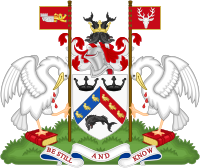
|
|
See also
- Armorial of UK universities
- List of universities in the United Kingdom
- Plate glass university
References
- ↑ 1.0 1.1 1.2 "Financial Statements for the Year to 31 July 2023". University of Sussex. p. 31. https://www.sussex.ac.uk/webteam/gateway/file.php?name=financial-statements-2022-2023.pdf&site=262.
- ↑ 2.0 2.1 2.2 Hall, Laura (28 January 2022). "Sasha Roseneil appointed as new Vice-Chancellor of University of Sussex". The Tab. https://thetab.com/uk/sussex/2022/01/28/sasha-roseneil-appointed-as-new-vice-chancellor-of-university-of-sussex-47745.
- ↑ 3.0 3.1 "Who's working in HE?". https://www.hesa.ac.uk/data-and-analysis/staff/working-in-he.
- ↑ 4.0 4.1 4.2 "Where do HE students study? | HESA". https://www.hesa.ac.uk/data-and-analysis/students/where-study#provider.
- ↑ 5.0 5.1 5.2 5.3 Carder, Tim. "University of Sussex – a potted history". http://www.mybrightonandhove.org.uk/page_id__6834.aspx.
- ↑ 6.0 6.1 6.2 "University of Sussex". 16 June 2021. https://www.timeshighereducation.com/world-university-rankings/university-sussex.
- ↑ "Facts and figures : Rankings and figures : About us : University of Sussex". http://www.sussex.ac.uk/about/facts/facts-figures.
- ↑ "Sussex named among most international universities in the world". http://www.sussex.ac.uk/staff/newsandevents/?id=48191?ref=email.
- ↑ "Historians at Sussex : About the Department : History : University of Sussex". http://www.sussex.ac.uk/history/about/historiansatsussex.
- ↑ Cragoe, Matthew (2015), Taylor, Miles, ed., "Asa Briggs and the University of Sussex, 1961–1976" (in en), The Age of Asa: Lord Briggs, Public Life and History in Britain since 1945 (London: Palgrave Macmillan UK): pp. 225–247, doi:10.1057/9781137392596_11, ISBN 978-1-137-39259-6, https://doi.org/10.1057/9781137392596_11, retrieved 2023-07-30
- ↑ "A potted history | University of Sussex | Universities and colleges | Places | My Brighton and Hove". http://www.mybrightonandhove.org.uk/page_id__6834.aspx.
- ↑ 12.0 12.1 12.2 12.3 "Sir Basil Spence Archive Project". http://www.basilspence.org.uk/learning/buildings/sussex-university.
- ↑ Ben Maples (2 Aug 2021). "What is a Student Union?". universitycompare.com. https://universitycompare.com/advice/student/student-union.
- ↑ "Modernism and rock 'n' roll – University of Sussex – Universities and colleges – Places – My Brighton and Hove". http://www.mybrightonandhove.org.uk/page/university_of_sussex?path=0p115p213p956p.
- ↑ "Obituary: Professor Ranajit Guha" (in en). https://www.sussex.ac.uk/broadcast/read/61233.
- ↑ Standke, Klaus-Heinrich (1 November 2006). "Sixty years of UN and UNESCO". http://www.klaus-heinrich-standke.de/admin/datenbank/secure/files/1402576641_.pdf.
- ↑ "News". The Badger Online. http://www.thebadgeronline.co.uk/news/huntingtondie.
- ↑ "'We thought we could change the world': Memories of Vietnam War protest at University of Sussex". http://www.theargus.co.uk/news/by_location/16043245._We_thought_we_could_change_the_world___Memories_of_Vietnam_War_protest_at_University_of_Sussex/.
- ↑ "University Challenge – Series Champions". http://www.blanchflower.org/uc/winners_teams.html.
- ↑ "Archived copy". http://m.sussex.ac.uk/alumni/pdfs/university-of-sussex-at-50.pdf.
- ↑ "Official Crest on Vellum a". Imagelib.sussex.ac.uk. https://imagelib.sussex.ac.uk/gallery2/v/pressandcomms/Oficcial+Crest+on+Vellum+a.jpg.html. [yes|permanent dead link|dead link}}]
- ↑ "Press release archive : News and events : University of Sussex". University of Sussex. http://www.sussex.ac.uk/press_office/media/media454.shtml.
- ↑ "Making the Future : University of Sussex". http://www.sussex.ac.uk/campaign.
- ↑ "Take part in community projects : Get involved : ... : About us : University of Sussex". http://www.sussex.ac.uk/about/community/get-involved/community-projects.
- ↑ "Open courses in modern languages : Modern languages : Sussex Centre for Language Studies : University of Sussex". http://www.sussex.ac.uk/languages/ml/opencourses.
- ↑ "Sussex Conversations : Events : News : University of Sussex". http://www.sussex.ac.uk/newsandevents/sussexconversations.
- ↑ "The economic and social impact of the University of Sussex". 1 November 2017. https://www.sussex.ac.uk/webteam/gateway/file.php?name=economic-impact-of-the-university-of-sussex.pdf&site=303.
- ↑ "Sussex appoints its first permanent Director for the Student Experience". University of Sussex. http://www.sussex.ac.uk/staff/newsandevents/?id=44079%3Fref%3Demail.
- ↑ "Victory: Sussex University goes Fossil Free!". People & Planet. 5 February 2018. https://peopleandplanet.org/blog/2018-02-05/victory-sussex-university-goes-fossil-free.
- ↑ "Students demand Sussex uni fire anti-trans professor Kathleen Stock: 'We've f**king had enough'". PinkNews. https://www.pinknews.co.uk/2021/10/07/kathleen-stock-university-sussex/.
- ↑ 31.0 31.1 Woolcock, Nicola (13 October 2021). "Universities union backs trans rights over threatened professor Kathleen Stock". The Times. https://www.thetimes.co.uk/article/universities-union-backs-trans-rights-over-threatened-professor-kathleen-stock-sgzz09j2f.
- ↑ Kelleher, Patrick (13 October 2021). "The University of Sussex has been accused of being hypocritical, "anti-student and pro-transphobia"". PinkNews. https://www.pinknews.co.uk/2021/10/13/kathleen-stock-sussex-university-trans-students/.
- ↑ "Shadow minister criticises Kathleen Stock for being LGB Alliance trustee". The Guardian. https://www.theguardian.com/society/2021/oct/13/shadow-minister-criticises-kathleen-stock-for-being-lgb-alliance-trustee.
- ↑ Mintz, Luke (26 September 2021). "A tale of two universities: How Sussex and Brighton's post-Covid offering couldn't be more different" (in en-GB). The Telegraph. ISSN 0307-1235. https://www.telegraph.co.uk/education-and-careers/2021/09/26/tale-two-universities-sussex-brightons-post-covid-offering-couldnt/.
- ↑ "How to get here : About us : University of Sussex". sussex.ac.uk. https://www.sussex.ac.uk/about/directions.
- ↑ "University of Sussex - Prospects.ac.uk". https://www.prospects.ac.uk/universities/university-of-sussex-4013.
- ↑ "Shops, facilities and retail outlets". Brighton: University of Sussex. http://www.sussex.ac.uk/rsts/1-2-1-1.html.
- ↑ 38.0 38.1 "About us". University of Sussex. http://www.sussex.ac.uk/about/.
- ↑ "University's listed building agreement is a first". University of Sussex. http://www.sussex.ac.uk/broadcast/read/30276.
- ↑ "Areas of Outstanding Natural Beauty: Landscape Protection and Enhancement Aid Scheme (England)". European Commission. http://ec.europa.eu/community_law/state_aids/agriculture-2006/n454-06.pdf.
- ↑ "The Gardner Arts Centre". http://www.gardnerarts.co.uk/about.html.
- ↑ "Gardner Arts Centre enters final season". University of Sussex. http://www.sussex.ac.uk/press_office/bulletin/15dec06/article1.shtml.
- ↑ "Sussex Research Hive : Support for research : Library : University of Sussex". http://www.sussex.ac.uk/library/research/hive.
- ↑ The University of Sussex (1990, 1991). The University of Sussex Undergraduate Prospectus 1991 OCLC 50454932
- ↑ "Bulletin". University of Sussex. 20 July 2001. http://www.sussex.ac.uk/press_office/bulletin/20jul01/article10.shtml.
- ↑ "Bulletin - University of Sussex Newsletter - Schools update - 19th September 2003". https://archive.sussex.ac.uk/news/bulletin/bulletin/www.sussex.ac.uk/internal/bulletin/archive/19sept03/article8.html.
- ↑ Wilmot, Rose. "The School of Media, Arts and Humanities to launch in 2020". http://www.sussex.ac.uk/broadcast/read/51824.
- ↑ "Schools and Departments". University of Sussex. https://www.sussex.ac.uk/about/who/schools-and-departments.
- ↑ "Two new heads of school to be appointed". The University of Sussex. 13 March 2012. http://www.sussex.ac.uk/education/newsandevents?id=12605.
- ↑ "Anthropology Goes Global", Sussex Anthropologist (newsletter), 1:1, Autumn 2009
- ↑ "Doctoral School : PhD : Study with us : University of Sussex". http://www.sussex.ac.uk/study/phd/doctoral.
- ↑ "New Chancellor Announced". University of Sussex. http://www.sussex.ac.uk/USIS/news/index.php?output=html&refer=23172&id=28702. [yes|permanent dead link|dead link}}]
- ↑ 53.0 53.1 53.2 "University Guide 2016 – The Times". http://nuk-tnl-editorial-prod-staticassets.s3.amazonaws.com/2016/bespoke/university-guide/index.html.
- ↑ "World University Rankings" (in en). 2023-09-25. https://www.timeshighereducation.com/world-university-rankings/2024/world-ranking.
- ↑ "QS World University Rankings 2015/16". QS Quacquarelli Symonds. https://www.topuniversities.com/university-rankings/world-university-rankings/2015.
- ↑ "University of Sussex". 16 July 2015. https://www.topuniversities.com/universities/university-sussex#sub.
- ↑ "Overall Rankings 2016 – UI GreenMetric". http://greenmetric.ui.ac.id/overall-ranking-2016/.
- ↑ "University League Tables 2021". https://www.thecompleteuniversityguide.co.uk/league-tables/rankings.
- ↑ "University League Table 2021". The Complete University Guide. 1 June 2020. http://www.thecompleteuniversityguide.co.uk/league-tables/rankings.
- ↑ "University league tables 2021". The Guardian. 5 September 2020. https://www.theguardian.com/education/ng-interactive/2020/sep/05/the-best-uk-universities-2021-league-table.
- ↑ "The Times and Sunday Times University Good University Guide 2021". Times Newspapers. http://nuk-tnl-editorial-prod-staticassets.s3.amazonaws.com/2016/bespoke/university-guide/index.html.
- ↑ "Academic Ranking of World Universities 2020". Shanghai Ranking Consultancy. http://www.shanghairanking.com/ARWU2020.html.
- ↑ "QS World University Rankings 2021". Quacquarelli Symonds Ltd.. https://www.topuniversities.com/university-rankings/world-university-rankings/2021.
- ↑ "World University Rankings 2021". Times Higher Education. https://www.timeshighereducation.com/world-university-rankings/2021/world-ranking#!/page/0/length/-1/sort_by/rank/sort_order/asc/cols/stats.
- ↑ 65.0 65.1 "Times Higher Education University ranking by Subject 2018 – Social Sciences". THE. 12 September 2017. https://www.timeshighereducation.com/world-university-rankings/2018/subject-ranking/social-sciences#!/page/0/length/25/sort_by/rank/sort_order/asc/cols/stats.
- ↑ "CWTS Leiden Ranking". http://www.leidenranking.com/ranking/2016/list.
- ↑ "Best Global Universities for Social Sciences and Public Health". https://www.usnews.com/education/best-global-universities/social-sciences-public-health.
- ↑ "QS World University Rankings by Subject 2016 – Development Studies". QS Quacquarelli Symonds. http://www.topuniversities.com/university-rankings/university-subject-rankings/2016/development-studies.
- ↑ "QS World University Rankings by Subject 2015 – Development Studies". QS Quacquarelli Symonds. http://www.topuniversities.com/university-rankings/university-subject-rankings/2015/development-studies#sorting=rank+region=+country=+faculty=+stars=false+search=.
- ↑ "QS World University Rankings by Subject 2018". QS Quacquarelli Symonds. https://www.topuniversities.com/subject-rankings/2018.
- ↑ "QS World University Rankings by Subject 2018". https://www.topuniversities.com/subject-rankings/2018.
- ↑ "Financial Statements 2016-17". https://www.sussex.ac.uk/webteam/gateway/file.php?name=3998-financial-statements-2016-17-final-web.pdf&site=262.
- ↑ "Our research : Research at Sussex : University of Sussex". http://www.sussex.ac.uk/research/about.
- ↑ 74.0 74.1 McGann, James G. (31 January 2018). "2017 Global Go To Think Tank Index Report". https://repository.upenn.edu/cgi/viewcontent.cgi?article=1012&context=think_tanks.
- ↑ "Doctoral Training Partnerships – Economic and Social Research Council". http://www.esrc.ac.uk/skills-and-careers/studentships/doctoral-training-partnerships/.
- ↑ "Home". http://senss-dtp.ac.uk/.
- ↑ "Results & submissions : REF 2014 : View results and submissions by institution". http://results.ref.ac.uk/Results/ByHei/172.
- ↑ "Harvard Sussex Program – The CBW Conventions Bulletin". https://sites.fas.harvard.edu/~hsp/pdf.html.
- ↑ "CHASE Members". http://www.chase.ac.uk/chase-members/.
- ↑ "About the Tyndall Centre | Tyndall Centre for Climate Change Research". http://www.tyndall.ac.uk/about.
- ↑ "Paul Scherrer Institut (PSI)". https://www.psi.ch/.
- ↑ "Organisations & Project team". http://www.sussex.ac.uk/geography/researchprojects/BAR/personnell_organistions.html.
- ↑ "Nexus team". The Nexus Network. 8 February 2018. http://www.thenexusnetwork.org/about/nexus-team/.
- ↑ "About". Centre on Innovation and Energy Demand (CIED). http://www.cied.ac.uk/about/.
- ↑ "Social media's 'big data' could help police understand hate crime : 16 October 2015 : ... : Bulletin : University of Sussex". http://www.sussex.ac.uk/internal/bulletin/staff/2015-2016/16102015/policinghatecrime.
- ↑ "Postdoctoral research : Research at Sussex : University of Sussex". http://www.sussex.ac.uk/research/postdoctoral.
- ↑ "University of Sussex/Institute of Development Studies – Habitat UNI". http://uni.unhabitat.org/?uni-partner=university-of-sussexinstitute-of-development-studies.
- ↑ "UK Trade Policy Observatory". https://blogs.sussex.ac.uk/uktpo/.
- ↑ "Partners – The Arctic Research Programme". http://arp.arctic.ac.uk/about/partners/#.
- ↑ "Impact and influence : SPRU – Science Policy Research Unit : University of Sussex". http://www.sussex.ac.uk/spru/impact.
- ↑ "Transformative Innovation Policy Consortium (TIPC)". http://www.transformative-innovation-policy.net/.
- ↑ "JEMS : Sussex Centre for Migration Research : University of Sussex". http://www.sussex.ac.uk/migration/jems/.
- ↑ "Michelle Lefevre : University of Sussex". http://www.sussex.ac.uk/profiles/28733.
- ↑ "Christian Henderson : University of Sussex". http://www.sussex.ac.uk/profiles/372397.
- ↑ "Carol Alexander : University of Sussex". http://www.sussex.ac.uk/profiles/2765.
- ↑ "Joseph Tidd : University of Sussex". http://www.sussex.ac.uk/profiles/41343.
- ↑ "Beate Jahn : University of Sussex". http://www.sussex.ac.uk/profiles/102133.
- ↑ "Graham Davey : University of Sussex". http://www.sussex.ac.uk/profiles/8681.
- ↑ "IDS Bulletin – IDS Bulletin". http://bulletin.ids.ac.uk/idsbo.
- ↑ 100.0 100.1 "UCAS Undergraduate Sector-Level End of Cycle Data Resources 2022". UCAS. Show me... Domicile by Provider. https://www.ucas.com/data-and-analysis/undergraduate-statistics-and-reports/ucas-undergraduate-sector-level-end-cycle-data-resources-2022.
- ↑ "2022 entry UCAS Undergraduate reports by sex, area background, and ethnic group". UCAS. 2 February 2023. https://www.ucas.com/data-and-analysis/undergraduate-statistics-and-reports/ucas-undergraduate-sector-level-end-cycle-data-resources-2022/2022-entry-ucas-undergraduate-reports-sex-area-background-and-ethnic-group.
- ↑ 102.0 102.1 "University League Tables entry standards 2023". The Complete University Guide. https://www.thecompleteuniversityguide.co.uk/league-tables/rankings?tabletype=full-table&sortby=entry-standards.
- ↑ "The Times and Sunday Times Good University Guide 2023". The Good University Guide (London). http://extras.thetimes.co.uk/gooduniversityguide/institutions/.(Subscription content?)
- ↑ "University guide 2018: league table for medicine". https://www.theguardian.com/education/ng-interactive/2017/may/16/university-guide-2018-league-table-for-medicine.
- ↑ "Partner Institutions : Partnerships : Academic Development and Quality Enhancement : University of Sussex". http://www.sussex.ac.uk/adqe/partnerships/institutions.
- ↑ "International degree preparation – University of Sussex ISC". Sussex.ac.uk. 9 May 2012. http://www.sussex.ac.uk/isc.
- ↑ "Study Group expand ISC at University of Sussex". https://thepienews.com/news/study-group-isc-in-sussex/.
- ↑ "BIMM Award Winning Music Colleges in Brighton, Bristol and Dublin". Bimm.co.uk. 2 March 2012. http://www.bimm.co.uk.
- ↑ "Music Facilities at BIMM". http://www.bimm.co.uk/facilities/.
- ↑ "All partner institutions : Study Abroad for Sussex Students : University of Sussex". http://www.sussex.ac.uk/students/support/studyabroad/partnerinstitutions.
- ↑ "Study Abroad for Sussex Students : University of Sussex". Sussex.ac.uk. http://www.sussex.ac.uk/students/support/studyabroad/index.
- ↑ "International Research Partnerships and Network Fund: University of Sussex". http://www.sussex.ac.uk/staff/research/sussexresearch/irpn.
- ↑ "Institutional partnerships : International partnerships : University of Sussex". http://www.sussex.ac.uk/international/partnerships/institutional.
- ↑ "Get involved | Sussex Students' Union". https://www.sussexstudent.com/get-involved/.
- ↑ "Discover sports & societies | Sussex Students' Union". https://www.sussexstudent.com/sport-societies-media/discover/.
- ↑ "Student Life Centre : Students : University of Sussex". https://www.sussex.ac.uk/studentlifecentre/.
- ↑ "AGCAS: Sussex wins AGCAS Award for Student Engagement 2016". http://www.agcas.org.uk/articles/1023-Sussex-wins-AGCAS-Award-for-Student-Engagement-2016.
- ↑ Ellett, Paul (19 October 2018). "Which? University Student Survey 2018: the results – Which?". University.which.co.uk. https://university.which.co.uk/advice/student-life/which-university-student-survey-the-results.
- ↑ "Undergraduate research : Research at Sussex : University of Sussex". http://www.sussex.ac.uk/research/undergraduate/.
- ↑ "International Junior Research Associate (IJRA) Scheme : Undergraduate research : Research at Sussex : University of Sussex". http://www.sussex.ac.uk/research/undergraduate/international-jra.
- ↑ "Research groups and networks : Our research : Research at Sussex : University of Sussex". http://www.sussex.ac.uk/research/about/groups.
- ↑ "Masters courses : Masters : Study with us : University of Sussex". http://www.sussex.ac.uk/study/masters/.
- ↑ "MSc and PhD study : SPRU – Science Policy Research Unit : University of Sussex". http://www.sussex.ac.uk/spru/study.
- ↑ "Masters scholarships: University of Sussex". http://www.sussex.ac.uk/study/masters/fees-and-scholarships/scholarships/search?sent=1&level%5B%5D=2®ion%5B%5D=1&year_of_entry%5B%5D=2018.
- ↑ Web Team. "Destinations". http://www.sussex.ac.uk/study/sabroad/forsussexstudents/destinations.
- ↑ "For First-Generation Scholars : About us : Careers and Employability Centre : Schools and services : University of Sussex". http://www.sussex.ac.uk/careers/aboutus/firstgeneration.
- ↑ Hakner, James. "Jeremy Corbyn meets first-generation students in University of Sussex visit". http://www.sussex.ac.uk/broadcast/read/41836.
- ↑ "Archived copy". https://www.offa.org.uk/wp-content/uploads/2017/06/OFFA-Monitoring-Outcomes-Report-2015-16-Final.pdf.
- ↑ "International degree preparation – University of Sussex ISC". Studygroup.com. 9 May 2012. http://www.studygroup.com/isc/sussex.
- ↑ "Study Abroad at Sussex : Study with us : University of Sussex" (in en). https://www.sussex.ac.uk/study/study-abroad-at-sussex.
- ↑ "Trips: International Summer School: University of Sussex". http://www.sussex.ac.uk/iss/1-4-12.html.
- ↑ "University of Sussex – US-UK Fulbright Commission". http://www.fulbright.org.uk/going-to-the-uk/uk-summer-institutes/summer-institutes-available/university-of-sussex.
- ↑ "International Year One". http://isc.sussex.ac.uk/our-courses/international-year-one.
- ↑ "Pre-Masters". http://isc.sussex.ac.uk/our-courses/pre-masters.
- ↑ "International policies | Sussex Students' Union". https://www.sussexstudent.com/democracy/policies/international/.
- ↑ "Accommodation : Study with us : University of Sussex". http://www.sussex.ac.uk/study/accommodation.
- ↑ "Archived copy". https://www.sussex.ac.uk/webteam/gateway/file.php?name=at-home-with-us-2016-17-final-proof.pdf&site=327.
- ↑ "University of Sussex plans to accommodate thousands more students unveiled". http://www.theargus.co.uk/news/local/14330592.University_of_Sussex_plans_to_accommodate_thousands_more_students_unveiled/.
- ↑ "Sussex University submits £200m plan for 1,900 student flats on Falmer campus". 7 January 2020. https://www.brightonandhovenews.org/2020/01/07/sussex-university-submits-200m-plan-for-1900-student-flats-on-falmer-campus/.
- ↑ "At Home with US". University of Sussex. http://www.sussex.ac.uk/residentialservices/documents/us_housing_07screen.pdf.
- ↑ "Bulletin – 2 November 2007". https://archive.sussex.ac.uk/news/bulletin/bulletin/www.sussex.ac.uk/internal/bulletin/archive/02nov07/article1.html.
- ↑ "Swanborough : Major projects completed : ... : Sussex Estates and Facilities : Schools and services : University of Sussex". http://www.sussex.ac.uk/sef/projects/major-projects-completed/swanborough.
- ↑ "Bulletin". University of Sussex. 9 October 2009. http://www.sussex.ac.uk/press_office/bulletin/09Oct09/article1.shtml.
- ↑ "East Slope Residences". 24 November 2020. https://www.sussex.ac.uk/study/accommodation/on-campus/student-village/.
- ↑ "Enabling works to start for West Slope development". 24 November 2020. http://www.sussex.ac.uk/broadcast/read/51483.
- ↑ "University of Sussex pledges to reach net zero by 2035" (in en-US). 15 July 2021. https://www.energylivenews.com/2021/07/15/university-of-sussex-pledges-to-reach-net-zero-by-2035/.
- ↑ "Facilities and services : Sussex sport : University of Sussex". http://www.sussex.ac.uk/sport/facilities.
- ↑ "Event and conference hire : Facilities and services : Sussex sport : University of Sussex". http://www.sussex.ac.uk/sport/facilities/conference.
- ↑ "Questions and answers : Falmer Stadium : University of Sussex". http://www.sussex.ac.uk/falmerstadium/qa.
- ↑ "BUCScore – University of Sussex Profile". https://www.bucs.org.uk/BucsCore/InstitutionProfile.aspx?id=159.
- ↑ "Getting to know the people behind the Sussex student radio". The Tab. 23 October 2016. https://thetab.com/uk/sussex/2016/10/23/sussex-radio-station-best-country-9339.
- ↑ "Digital radio coverage expanded to thousands across Sussex". The Argus. 15 December 2015. http://www.theargus.co.uk/news/14146305.Digital_radio_coverage_expanded_to_thousands_across_Sussex/.
- ↑ "URF Online". http://www.urfonline.com.
- ↑ "News & Events | URF | URF" (in en). https://www.urfonline.com/news-events/.
- ↑ "2008 Student Radio Awards". http://www.studentradio.org.uk/awards/08/winners.php.
- ↑ "Inside the BBC Helen Boaden, Former Director, Radio". BBC Corporate. https://www.bbc.co.uk/corporate2/insidethebbc/managementstructure/biographies/boaden_helen.
- ↑ "University of Sussex Development and Alumni Relations Kit Bradshaw". http://www.sussex.ac.uk/alumni/newsandfeatures/successaftersussex/spotlighton/kitbradshaw.
- ↑ Fox, Thomas (2022-03-03). "BBC's Clive Myrie's life in Sussex where he had 'turning point' in life" (in en). https://www.sussexlive.co.uk/news/sussex-news/clive-myrie-bbc-sussex-kyiv-6746140.
- ↑ Young-Powell, Abby (5 December 2013). "Five students at Sussex Uni banned from campus for 'peaceful protest'". The Guardian. https://www.theguardian.com/education/2013/dec/05/students-sussex-suspended.
- ↑ "NaSTA Conferences and Awards". NaSTA. http://nasta.tv/awards/.
- ↑ "Gupta, Shantanu" (in en). 2021-09-20. https://in.sagepub.com/en-in/sas/author/shantanu-gupta.
- ↑ "Shantanu Gupta" (in en). November 3, 2017. https://timesofindia.indiatimes.com/litfest/litfest-2017/speakers/shantanu-gupta/articleshow/61117281.cms.
- ↑ "Mr. Shantanu Gupta" (in en-US). https://www.hua.edu/people/mr-shantanu-gupta/.
- ↑ "Anthony J. Leggett". Nobel Foundation. http://nobelprize.org/nobel_prizes/physics/laureates/2003/leggett.html.
- ↑ "Sir Paul M. Nurse". Nobel Foundation. http://nobelprize.org/nobel_prizes/medicine/laureates/2001/nurse.html.
- ↑ "Archer John Porter Martin". Nobel Foundation. http://nobelprize.org/nobel_prizes/chemistry/laureates/1952/martin.html.
- ↑ "Martin, Archer John Porter". Oxford Dictionary of National Biography (online ed.). Oxford University Press. doi:10.1093/ref:odnb/77176. (Subscription or UK public library membership required.)
- ↑ "John Warcup Cornforth". Nobel Foundation. http://nobelprize.org/nobel_prizes/chemistry/laureates/1975/cornforth.html.
- ↑ "Sir Harold W. Kroto". Nobel Foundation. http://nobelprize.org/nobel_prizes/chemistry/laureates/1996/kroto.html.
- ↑ "Crafoord Prize 1999". http://www.crafoordprize.se/press/arkivpressreleases/thecrafoordprize1999.5.32d4db7210df50fec2d800018201.html.
- ↑ "University of Sussex Media Release Japan's "Nobel Prize" for Sussex University biologist". https://archive.sussex.ac.uk/news/press-releases/media/media148.html.
- ↑ "Search results – British Academy". https://www.britac.ac.uk/search-results?keyword=sussex&content_types%5B%5D=fellows. [yes|permanent dead link|dead link}}]
- ↑ "Rv Ca Dr Gavin Ashenden : School of English". University of Sussex. http://www.sussex.ac.uk/english/people/peoplelists/person/79.
- ↑ "University of Sussex – Coat of arms (crest) of University of Sussex". http://www.ngw.nl/heraldrywiki/index.php?title=University_of_Sussex.
- ↑ "Sussex artefacts". University of Sussex. https://www.sussex.ac.uk/about/60-years-of-sussex/60-objects/artefacts-objects. Retrieved 20 November 2022.
External links
- University of Sussex website
- Brighton and Sussex Medical School
- University of Sussex Students' Union website
- University of Sussex Library website
[ ⚑ ] 50°51′55″N 0°05′08″W / 50.86528°N 0.08556°W
 |
 KSF
KSF